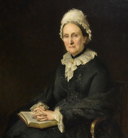
-
Celebrations begin to commemorate 50 years of the University of Dundee
2017 -
The University of Dundee becomes a fully independent institution under the terms of the Royal Charter.
1967 -
Ordinances issued in 1897 made University College form part of St Andrews. and establish a Faculty of Medicine.
1897 -
The Deed formally creating University College Dundee was signed by founders Miss Mary Ann Baxter and her cousin Dr John Boyd Baxter.
1881
Theatres
-
date
Fri, 08 Sep 2017
-
Running Time
00:05:25
Dundee Repertory Theatre is much more than a neighbour to the University of Dundee.
Episode Transcript
Dundee Rep and other theatres Dundee Repertory Theatre is much more than a neighbour to the University of Dundee. As well as being built on ground donated by the University, the theatre has also worked with the School of Humanities to deliver an MLitt in Theatre Studies, a chance for potential playwrights and other theatre professionals to gains hands-on experience of the industry.
There have many impressive theatres in Dundee. With the twentieth century and the advent of moving pictures, however, they became cinemas; and once televisions appeared in our homes, many closed their doors completely. Some were transformed for other entertainment such as bingo halls and dancing.
The façade to the 1810 Theatre Royal can still be seen in Castle Street, with the bust of Shakespeare high above the only indication of what used to take place there. The Alhambra Theatre still stands on Bellfield Street. Renamed the Whitehall Theatre in the 1970s, it still offers family entertainment, but there was also the Alhambra Music Hall in East Dock Street, a wooden building that was declared dangerous in 1867 and closed. Music lovers only had to shift their attention to the Dundee Music Hall located in the old Exchange Building in the neighbouring Exchange Street.
Dundonians could also choose from Her Majesty's Theatre in the Seagate, the Dundee Empire Theatre of Varieties in Rosebank Street, Victoria Hall (later the Gaiety) on Victoria Road, and the cavernous Palace on the Nethergate, which held 2500 people. The Kinnaird Hall in Bank Street, on a site made available by Lord Kinnaird, also held 2500 people and The Hippodrome opened at 160 Hawkhill as a variety house. This too, as The Princess, became a cinema. There is a dedicated band of campaigners who are determined to save the King’s Theatre in the Cowgate, which is the largest remaining theatre, but is now a Building at Risk following years of use as cinemas and nightclubs. By the end of the 1930s the dominance of cinema meant that there was no designated theatre for drama - but Dundee had the second largest cinema in Europe at the Green's Playhouse in the Nethergate.
So when, in May of 1939, Dundee Repertory Theatre was founded, it performed from Foresters' Hall in Nicoll Street. That came to a sad and abrupt end after a fire in 1963, when it had something of a peripatetic existence before settling in the former Dudhope Church on Lochee Road.
The reputation of the company was such that it required a home and in January 1979 work began on the building that would sit at the north of the elegant Georgian Tay Square. When rising prices looked as if they would bring the project to a halt, a public appeal raised £200,000 and the building opened in April 1982.
Philanthropy was also at the heart of the Caird Hall. Built with money donated by jute manufacturer Sir James Caird, the construction of this and a new City Chamber meant the demolition of the Vault, the Greenmarket and the 18th century Town House. Today, Dundee Rep as its more commonly known, has been is joined by The Little Theatre, the home of Dundee Dramatic Society, who bought the upper two floors of a former jute warehouse in 1936 and there they still perform. The newest addition, the Gardyne Theatre in West Ferry, opened first in 1973 as part of the Northern College of Education, but was given a new lease of life as part of Dundee and Angus Colleg’s Gardyne Campus.
There is another link between The University and Dundee Rep, The Bonar Hall, which plays a main rile in each year's Dundee Literary Festival and many other special events. Built in 1977, it was named after Sir Herbert Bonar of the jute manufacturing family who funded the building for the use of the University and the people of Dundee.
Eddie Small

Eddie Small is a lecturer in Creative Writing at the University of Dundee. He was awardedthe Student-led 'Most Inspirational Teacher at the University' prize in May 2016. Hisbiography of Mary Lily Walker, Forgotten Visionary of Dundee, was launched in 2013, andhe was asked to write a play, Dundee's Four Marys, which has been performed 7 times. Hewrote and performed in ‘Pantomime of Death’ at the 2016 Edinburgh Fringe. A committedlocal historian, he regularly give walking tours of his city.
-
Celebrations begin to commemorate 50 years of the University of Dundee
2017 -
The University of Dundee becomes a fully independent institution under the terms of the Royal Charter.
 1967
1967 -
Ordinances issued in 1897 made University College form part of St Andrews. and establish a Faculty of Medicine.
1897 -
The Deed formally creating University College Dundee was signed by founders Miss Mary Ann Baxter and her cousin Dr John Boyd Baxter.
 1881
1881